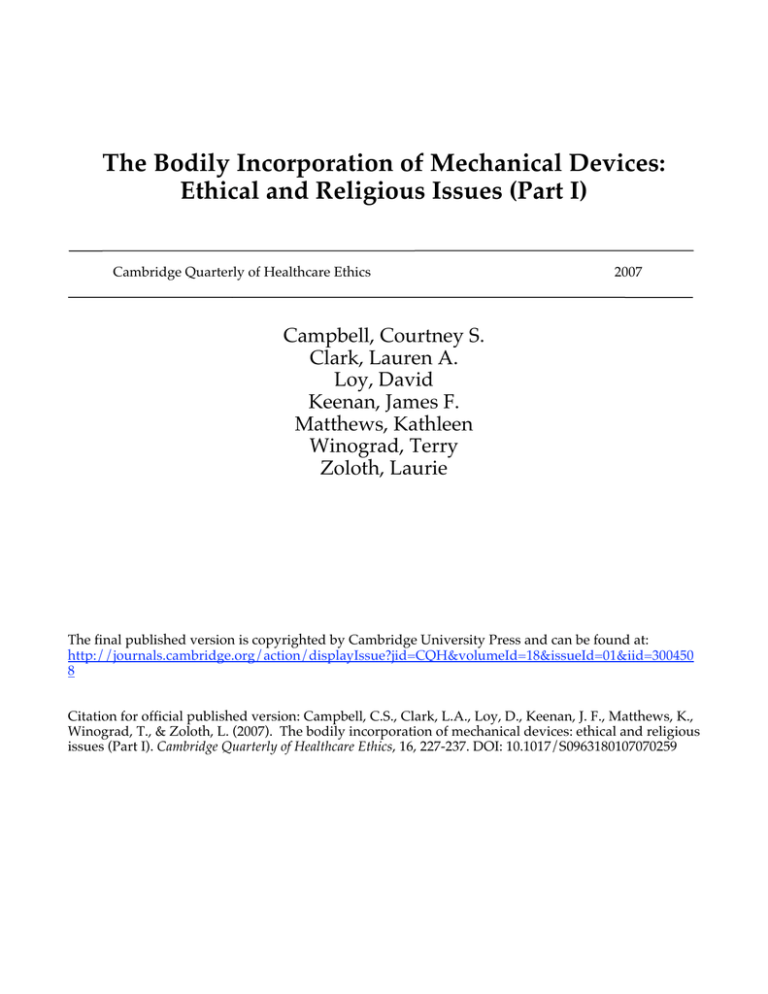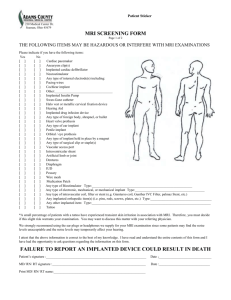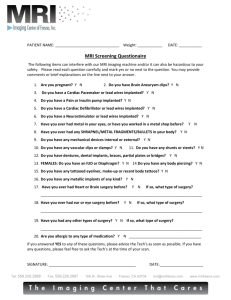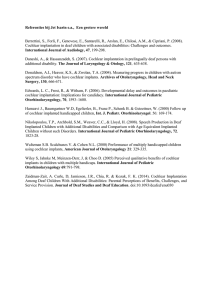The Bodily Incorporation of Mechanical Devices:
advertisement

The Bodily Incorporation of Mechanical Devices: Ethical and Religious Issues (Part I) Cambridge Quarterly of Healthcare Ethics 2007 Campbell, Courtney S. Clark, Lauren A. Loy, David Keenan, James F. Matthews, Kathleen Winograd, Terry Zoloth, Laurie The final published version is copyrighted by Cambridge University Press and can be found at: http://journals.cambridge.org/action/displayIssue?jid=CQH&volumeId=18&issueId=01&iid=300450 8 Citation for official published version: Campbell, C.S., Clark, L.A., Loy, D., Keenan, J. F., Matthews, K., Winograd, T., & Zoloth, L. (2007). The bodily incorporation of mechanical devices: ethical and religious issues (Part I). Cambridge Quarterly of Healthcare Ethics, 16, 227-237. DOI: 10.1017/S0963180107070259 | | 䡬 Biotechnology and Bioethics The Bodily Incorporation of Mechanical Devices: Ethical and Religious Issues (Part I) COURTNEY S. CAMPBELL, LAUREN A. CLARK, DAVID LOY, JAMES F. KEENAN, KATHLEEN MATTHEWS, TERRY WINOGRAD, and LAURIE ZOLOTH A substantial portion of the developed world’s population is increasingly dependent on machines to make their way in the everyday world. For certain privileged groups, computers, cell phones, PDAs, Blackberries, and IPODs, all permitting the faster processing of information, are commonplace. In these populations, even exercise can be automated as persons try to achieve good physical fitness by riding stationary bikes, running on treadmills, and working out on cross-trainers that send information about performance and heart rate. Still, these examples of everyday human interaction with a mechanized world presuppose an ability to differentiate between ourselves in our organic and bounded embodiedness and the “other” we encounter as an external mechanical artifact of technology. This boundary, which, in actuality, has been permeable for several centuries, may be dissolving further as new mechanical devices are introduced in biomedicine and incorporated in the body. The terrain of contemporary medicine is, in fact, permeated with innovative technologies to restore, repair, rehabilitate, and, in rare cases, enhance our physical and psychological capacities. Consider recent examples about the devices used to assist a soldier who has lost a limb in the war in Iraq and a quadriplegic who was enabled to have neural control over external devices. Sgt. David Sterling lost his right hand and forearm from an IED in Iraq, and <|| | 1| | now wears a myoelectric forearm (which cost $85,000). This forearm not only allows him to have use of an artificial hand, but also to snap on “kitchen devices, work tools, [and a] separate hand that help him write, play golf, shoot pool, even cast a fishing rod.” 1 Although not organically part of his body, the myoelectric device has now been incorporated to become one of his two arms. Even more recent research has focused on overcoming loss of motor control by patients through an electronic brain implant or neuroprosthesis. In July 2006, a report in Nature described the success of researchers at Brown University in implanting an electrode array into the brain of quadriplegic patient Matthew Nagle. Nagle, who had been deprived of control over his nervous system for three years following a violent assault, was able to control a computer cursor, open e-mail, control a television, and move objects with a robotic arm.2 This essay is drawn from collaborative research conducted under the auspices of the “Altering Nature: How Religious Traditions Assess the New Biotechnologies” project at Rice University from 2002 to 2004 through the financial support of The Ford Foundation (Grant #1010-1601). The paper is submitted with the permission and acknowledgement of the project coordinators and The Ford Foundation. The authors also acknowledge the research and editorial assistance of Dr. Siobhan Baggot and Ms. Sarah Gehrke. Cambridge Quarterly of Healthcare Ethics (2007), 16, 227–237. Printed in the USA. Copyright © 2007 Cambridge University Press 0963-1801/07 $16.00 CQH16(2) 07025 1/11 12/01/06 3:22 pm 䡬 227 log no. CQH07025 Page: 227 䡬 | | 䡬 Biotechnology and Bioethics 䡬 These and similar developments have led researchers in Science to speculate on “bringing the dream of merging man and machine closer to reality.” 3 At some point, perhaps, the “other” that is machine will be increasingly difficult to differentiate from the “self” that is embodied. Rodney A. Brooks, director of the Artificial Intelligence Laboratory at the Massachusetts Institute of Technology, observes: “While we have come to rely on our machines over the last fifty years, we are about to become our machines during the first part of this millennium.” 4 In this essay, we consider the implications of the increasing mechanization of the body, using both external and implanted devices, as well as the prospects of a human–machine merger, for understandings of our identity as embodied beings. We are interested in assessing moral and existential differences in the use of devices that intervene in organic processes of bodily functioning as distinguished from higher order brain functioning, as well as the extent to which there may be enhancement uses of existing therapeutic devices. Our analytical focus will draw on the ethics of the world’s classic religions, from which we elicit three patterns of normative response — appropriation, ambivalence, and resistance. Generally speaking, in these traditions, mechanical interventions on bodily processes, such as restoring mobility to impaired soldiers, are ethically uncontroversial and follow the pattern of appropriation insofar as they meet standards of safety and efficacy. However, certain circumstances (military applications) or forms (neurocognitive interventions) may elicit caution or ambivalence, if not outright resistance, to incorporating medical devices. The prospect of an electrode array for enhanced hearing or vision or a computer chip implanted in the brain that might expand faculties such as memory and reasoning powers present enhancement possibilities over our natural bodily endowments that some religious traditions are willing to appropriate, whereas other traditions find such developments contrary to the realization of our authentic human nature, identity, and destiny. We will begin our analysis with an overview of both research developments, clinical applications, and projected aspirations about the degree of impingement of mechanical devices on the body. We then turn to a discussion of the religious meaning and implications of this body–machine incorporation. We develop the three patterns of appropriation, ambivalence, and resistance as themes of religious response, contending it is important to differentiate between those mechanical devices that primarily impinge on the organic processes and functioning of the body and those devices that are directed at interventions in cognitive states or in the nature of human consciousness. Furthermore, we find that the integrity of religious traditions is intrinsically bound to questions of the common good and social justice. This concern, although not uniquely religious, has deep roots in various traditions and is manifested both in concerns about equitable distribution of beneficial resources, and the priorities such research and its clinical diffusion should have when many basic healthcare needs in some societies, such as the United States, continue to be unmet. In this essay, we make deliberate use of the language of “incorporation” technologies or devices. “Incorporation,” with its etymological roots stemming from Latin words for the body, seems to best convey a broad understanding of the technological–human phenomena we seek to describe and assess. That is, “incorporation” refers to the union or combination or inclusion of a mechanical device within something already formed, namely, the human body, so as to 228 CQH16(2) 07025 2/11 12/01/06 3:22 pm 䡬 Page: 228 | | 䡬 Biotechnology and Bioethics form a united whole. The meaning we intend through the language of “incorporation” is expressed well in the words of one researcher describing research success with the movement of an external robotic arm through a neuralcomputer interface in a rhesus monkey: “[T]he brain is so amazingly adaptable that it can incorporate an external device . . . as a natural extension of the body.” 5 <|| | 2| | Machines and the Body: Research Although the “dream” of human–machine merger may be a relatively new phenomenon, mechanical devices have been exploited for centuries in both eastern and western cultures.6 There are three distinct modes of technological intervention in the body: chemical (including genetic), mechanical, and electrical (including computational). What is different in the 21st century about mechanical interventions is the scale on which devices are built and their coupling with electrical devices. Technologies developed for computer chips can be used to create Micro-Electro-Mechanical Systems (MEMS), such that a device the size of a grain of rice can contain a complex mixture of physical and computational elements. On the much smaller scale of nanotechnology, researchers are developing molecule-sized physical machines that have been tested in animals. Although most devices are directed toward therapeutic objectives, the boundary between therapeutic and enhancement is blurry because the possibility of enhancement in many circumstances is parasitic on the knowledge gained through therapeutic interventions.7 䡬 Body Impingement Responses to uses of mechanical devices are often strongly shaped by how the technology impinges on the body. A device we don as part of our clothing is experienced as much less problematic than a device implanted within the body. We present here examples of different degrees of impingement; nevertheless, for our purposes, an incorporated device requires a more-or-less permanent and irreversible level of impingement. Worn. The least intrusive technology can be donned and doffed at will. Eyeglasses, hearing aids, false teeth, limb braces, and other assistive technologies possess a quality of easy reversibility. This quality supports a perception of voluntary use of such technologies, though, of course, such uses are not immune from coercive contexts, including societal expectations. Attached. Some technologies are external to the body but are attached in a more permanent or invasive way, such as the electronic tracking anklet 8 or prosthetic limbs. Although external to the body, mechanical devices that are attachments seem more invasive of the body and of privacy than worn devices. Although attached devices still offer voluntary removability, the freedom to do so may be constrained by public safety. Penetrating. Some devices, such as cochlear implants or feeding tubes, have components both inside and outside the body, requiring ongoing body pen229 CQH16(2) 07025 3/11 12/01/06 3:22 pm 䡬 Page: 229 | | 䡬 Biotechnology and Bioethics etration. External insulin pumps for diabetics insert chemical tubes through the skin. Neuroprosthetics research, such as the electrode array implanted in a quadriplegic patient’s brain in studies at Brown University, is but the most recent form of this intervention.9 Many people experience a psychological difference between a device attached externally to the body and a device that penetrates the skin. The skin has always been a boundary for the self, and penetrating this boundary can constitute a profound invasive violation of not only the body but the person.10 Penetrating technologies thereby raise different experiential and ethical issues than worn or attached technologies. Implanted. A further level of impingement involves implanting the device fully within the body. The device is incorporated as part of the body, rather than being something worn or attached with relative ease of removal and reversibility. An implanted technology, such as the paradigmatic cardiac pacemaker, generally implies permanence and irreversibility (or at least difficulty in removal). This can generate reconceptualizations of the boundaries of self, body, and machine. 䡬 Transembodied. The final (and still purely fantasy) degree of impingement would involve the creation of a new physical substrate into which a person’s memories or mind would be transferred. In some scenarios, the self-as-mind is disembodied or transembodied and, with the aid of electrical, digital, and computational technology, is transported into a mechanized home, such as a computer.11 Table 1 provides an overview of some prominent or widely used incorporated devices, as arranged by one of the three modes of technological interventions — chemical, mechanical, or electrical — and the extent of bodily impingement. We now discuss some representative examples of incorporated devices in more detail, attending to both current uses and proposed applications within the next generation. <|| | 8| | Table 1. Intervention method Impingement Worn Chemical Nicotine or hormone patches Mechanical Eyeglasses, contact lenses Electrical Hearing aids Attached Penetrating Implanted Transembodied Insulin pumps Contraceptive implants Artificial limbs Feeding tubes, dialysis machines Cochlear implants, cosmetic implants Computer substrate for mind “transplant” TENS current for pain relief Neural implant, brain pacemaker Cardiac pacemakers Computer substrate for mind “transplant” 230 CQH16(2) 07025 4/11 12/01/06 3:22 pm 䡬 Page: 230 | | 䡬 Biotechnology and Bioethics Implanted Medical Electronics Implanted electronics have been used for medical purposes for almost half a century, beginning with cochlear implants and the implantable heart pacemaker in the late 1950s. In general, these devices are penetrating or embedded mechanical devices that facilitate a therapeutic objective, namely, bringing functionality that is lost or missing through mechanical and electrical modes of intervention. The functionality sought can be physical (e.g., heart pacemakers and ventricular assist devices, artificial limbs), chemical (e.g., insulin pumps), or sensory (e.g., cochlear and retinal implants). Hearing. The most developed sensory device is the cochlear implant, which was introduced for use in 1957.12 The cochlear implant uses an external microphone to gather sound waves, which are converted into electrical impulses and transmitted to a microelectrode array permanently implanted within the cochlea. The electrodes then stimulate the auditory nerve. Some 70,000 profoundly deaf persons worldwide have received cochlear implants, and, of these, 40,000 can hear well enough with their implant to engage in conversation.13 Research has recently been directed to developing a new generation of electrode implants for brain stem auditory centers.14 If the auditory nerve is damaged, an auditory brain implant (ABI) can directly stimulate the auditory brain stem. The most successful method of stimulation at present is a penetrating ABI, which is inserted into the ventral cochlear nucleus. Despite regulatory approval and pervasive use, some arguments claim that even therapeutic uses of cochlear implants can be disruptive to the integrity of subcultures.15 Moreover, ethical questions for the broader culture will arise when such implants are used for enhancement. A hearing implant designed to pick up sounds that would not be audible in the normal human range is increasingly possible. Because the implant is likely (with foreseeable technology) to interfere with normal hearing, the recipient would be taking a risk in choosing (or being persuaded) to add enhanced hearing ability for recreational, professional, or military uses. 䡬 Vision. If a medical device can assist hearing for a deaf person, perhaps sight is possible for those who are blind. Current research now focuses on restoring some vision to persons who are blind through retinal implants. Although researchers are far from reproducing normal vision in a blind person, functional sight that enables people to navigate daily life situations can be restored. In September 2004, the FDA approved the first implantable lens for extreme nearsightedness.16 VisionCare Ophthalmic Technologies has tested an implanted intraocular device, called the “Implantable Miniature Telescope,” in a research study of 193 patients with age-related macular degeneration. The IMT uses two lenses to enlarge objects by up to three times and thus projects an image over a wider and healthier area of the retina.17 In the clinical trial, 141 patients showed improved distance and near visual acuity one year after the implantation. However, in July 2006, the FDA ophthalmic devices panel recommended against approval on grounds of safety.18 Visual implants are not as advanced as cochlear implants yet, because the retinal-neuronal system is far more complex than the auditory system. Also, 231 CQH16(2) 07025 5/11 12/01/06 3:22 pm 䡬 Page: 231 | | 䡬 Biotechnology and Bioethics experimental approaches differ on the optimal location at which the sensory information is directed into the nervous system, such as the retina, the optic nerve, or the visual cortex in the brain. Some approaches are invasive (e.g., retinal implants or direct stimulation of the optic nerve or visual cortex) and others are wearable and noninvasive (e.g., a vibrating pin array worn on the skin that receives input from a camera). The therapeutic uses of retinal implants are ethically uncontroversial. However, ethical questions of justice, access, and autonomy will be more pronounced when visual technologies reflect enhancement objectives. For example, cameras are able to respond to a much wider range of signals from different sources than the normal human visual system, and the output of those cameras (infrared vision, magnified vision, low-light vision) can produce a signal that enhances vision. 䡬 Internal Organs: Heart. There are many uses of penetrating or implanted electronic technologies for internal organs. In some cases, they provide direct electrical stimulation (e.g., pacemakers), in others they control a physical device (an artificial heart) or regulate a biological process (heart valves), and in others they control chemical flow (such as an insulin pump for persons with diabetes). Here we provide a brief overview of developments in mechanizing heart rhythm, structure, or function. The first totally implantable pacemaker was embedded in 1960. A sustained programmatic effort was stimulated by a research challenge issued in 1964 by the U.S. National Heart, Lung, and Blood Institutes to develop an artificial heart. Subsequent research on mechanical heart devices for persons with heart disease has seen some progress and noticeable setbacks. In 1982, Barney Clark became the first person to receive the Jarvik-7 total artificial heart, an incident that generated substantial ethical debate.19 In the summer of 2001, AbioCor introduced the first self-contained total artificial heart (TAH),20 which, unlike the Jarvik heart, is intended to be a destination device. “A TAH implant is a dramatic event that removes the patient’s heart and results in complete dependence on the most sophisticated technology ever implanted in humans.” 21 Although the Abiocor heart has yet to meet expectations for reliability, still, as articulated by researchers writing in Science, “the ultimate goal is to develop a machine that is as good or even better than (a) donor heart, avoiding the need for a transplant altogether.” 22 In 1993, the FDA approved the use of the left ventricular assist device (LVAD) as a bridge to a heart transplant. The LVAD supports the left ventricle, enabling damaged heart muscle to repair itself and contract more vigorously. In some cases, muscle repair has been substantial enough for the person to no longer need a transplant upon removal of the device. McCarthy and Smith contend that “the goal is for wider application of LVAD support so that heart failure patients are supported for weeks or months until cardiac damage has been repaired sufficiently such that a transplant is not necessary.” 23 The heart has long had special cultural, religious, psychological, and symbolic status, and thus its replacement with a mechanical device would seem to pose questions about the moral implications of implanted devices more sharply than devices that assist or replace other internal organs. Although cardiac pacemakers are commonplace — and, in fact, have barely caused any ethical ripples — whole-heart mechanical replacements continue to generate many se232 CQH16(2) 07025 6/11 12/01/06 3:22 pm 䡬 Page: 232 | | 䡬 Biotechnology and Bioethics rious medical complications. However, widespread public acceptance of cardiac assist devices suggests there is a range of moral flexibility with integration of machines and the heart so long as the technology is shown to be safe and effective. Neural Control of External Devices Science fiction presents a long history of imaginative possibilities on how, via computers, people can use the mind to interact directly with a world beyond their immediate bodily reach. An equally engaging body of literature deals with possibilities for “mind control” in which implanted or external devices can reveal and/or exert influence on a person’s thoughts. The basic neurophysiology of neuronal pathways suggests that these possibilities are not entirely fictional. Indeed, observes an editorial in Nature, “Systems that allow a brain to control a computer are inching ever closer to reality.” 24 Penetrating or implanted devices that engage the mind–body continuum raise social, psychological, and ethical questions about personal identity and selfhood. As with embedded microelectronic technologies, most neural cognitive research conducted so far is therapeutic. This research has been directed in particular to providing control over artificial limbs, as illustrated by the prosthetic devices available to injured soldiers, or providing motor function to people with neuro-muscular dysfunction. One branch of research combines increasing abilities to receive and process external neurophysiological signals (monitors of brain waves or muscle nerve activity or PET scans) with developing more effective ways to couple brain activities with action. The most developed method involves the use of neuromuscular signals to control devices that correspond to movement of the muscles. The clearest application of this research is in providing control of an artificial limb, where signals from the corresponding muscles (or other muscle groups, such as the back) can control the device. A more invasive approach taps directly into neural signals through some form of implanted array. The obvious risks (infection and inadvertent destruction of neurons) mitigate against this approach, but such research has been conducted on patients with diseases such as ALS,25 as well as in quadriplegic patients who have experienced mental control over external devices. The invasive nature of the latter research is defended on the grounds of greater long-term potential for patients, with an eventual expectation of an implanted wireless device that will send neuronal signals to not only computers but also parts of the body.26 Direct neural stimulation, in which electrical signals are transmitted to specific areas of the brain, has been effective in the treatment of central nervous diseases, such as Parkinson’s disease and seizures.27 Medtronic, a corporate leader in the heart pacemaker field, developed and received regulatory approval for Activa Therapy for “deep brain stimulation,” the functional equivalent of a brain pacemaker to treat patients with symptoms of Parkinson’s disease. An implanted neurostimulator sends electrical pulses under patient control to stimulate the brain. Some patients have reported significant lifestyle functions restored, such as drinking a cup of coffee or walking.28 Thirty thousand patients have received the electrode implant worldwide, and in the United States, Medicare pays the $30,000–40,000 cost for the procedure.29 䡬 233 CQH16(2) 07025 7/11 12/01/06 3:22 pm 䡬 Page: 233 | | 䡬 Biotechnology and Bioethics As researchers map more neural pathways, anticipated applications will raise many of the same ethical problems as other implanted electronics when extended to enhancement objectives. Observes Ramez Naam: “As we learn how to repair damaged brains, we’ll discover an immense amount about how the brain works. That in turn will lead to devices that can improve our mental abilities. . . . These abilities will pose serious questions to our sense of identity and individuality. They will blur the line between man and machine.” 30 The Cyber Soldier 䡬 For millennia, one of the greatest incentives for developing technologies that enhance capacities has been warfare. A political perception of increasing threats to security, and a change in military thinking about the types of weapons and warfare that conventional soldiers will experience has culminated in a view that innovative biotechnologies, especially defensive and protective technologies, will need to be developed for 21st century warfare. Not surprisingly, several such research projects have been sponsored by the U.S. Department of Defense, primarily through the Defense Advanced Research Projects Agency (DARPA).31 These projects endeavor to augment the capacities of soldiers or “warfighters” through more sophisticated weaponry, armor, and sensory enhancement. Michael Goldblatt, head of the Defense Services Office in DARPA, writes that the agency is exploring “augmenting human performance to increase the lethality and effectiveness of the warfighter by providing for super physiological and cognitive capabilities.” 32 One current DARPA project, known as ASSIST, seeks to augment the soldier’s perception and memory with “augmented reality,” which amplifies natural vision and brings additional information to the soldier in real time.33 The Moldice proposal is a longer term research project to generate real-time conversion of biomolecular signals into electrical signals, which could be used for neural control of external devices such as vehicles or weapons. The Mesoscope Integrated Conformal Electronics (MICE) program studies imprinting electronic circuits, antennas, fuel cells, batteries, and solar cells on glasses and helmets or weaving these circuits into clothes.34 The aim of these, and other related projects, contends Goldblatt, is that “soldiers having no physical, physiological or cognitive limitations will be key to survival and operational dominance in the future.” 35 Nanomedicine Nobel Prize winner Richard P. Feynman speculated in 1959: “[I]t would be interesting in surgery if you could swallow the surgeon. You put the mechanical surgeon inside the blood vessel, and it goes into the heart and ‘looks’ around. It finds out which valve is the faulty one and takes a little knife and slices it out. Other small machines might be permanently incorporated in the body to assist some inadequately-functioning organ.” 36 Feynman’s vision, which predates computer chips, of a “swallowed surgeon” or small machine doing repair work on body systems is in theory, though not in details, the principle underlying nanotechnology and nanomedicine. Nanotechnology applies broadly to any technology that takes advantage of mechanical properties on a molecular scale. 234 CQH16(2) 07025 8/11 12/01/06 3:22 pm 䡬 Page: 234 | | 䡬 Biotechnology and Bioethics Both the NIH and researchers in regenerative medicine have ambitious aspirations for nanotechnology. Nanomedicine holds out the potential for the reversal or prevention of paralysis and blindness through spinal cord regeneration, heart and blood vessel regeneration, therapies for Alzheimer’s, Parkinson’s, and diabetes, minimization of stroke impairments, repair of all bone fractures, and access to new cartilage.37 Other researchers have turned to nanotechnology as a mode of treatment for brain cancers. Medical advances in this area have been hindered by the “blood–brain barrier” that prevents most small- and large-molecule drugs from entering the brain. To deliver drug treatment across the blood–brain barrier, researchers have developed nano-containers, which function as a “molecular Trojan horse.” This method has successfully been carried out in mice, rats, and rhesus monkeys, as well as in cells in the laboratory, and the question now is “whether it is possible to move from the petri dish to persons.” 38 Despite its relative newness, some scholars have already decried the gap between the scientific research on nanotechnology and the paucity of analysis of its ethical and social implications. They have identified several ethical considerations generated by nanotechnology — among them matters of equity, privacy and security, environmental risk, and metaphysical questions about the status of human–machine interactions — and maintained that neglecting ethical analysis of nanotechnology risks derailing scientific research on nanotechnology in a manner analogous to research on genetically modified foods.39 䡬 Consciousness and Disembodied Immortality A speculative form of human–machine integration, one in which the person is disembodied and does become a machine, envisions that the essence of a person (the mind) can be transported to a completely different hardware substrate than the body, even while retaining the identity and consciousness of the individual.40 Relying on a strong mind/body dualism, the entire premise of this proposal requires an ability to dissociate mind and body that is fundamentally open to question. The hope for success is based on an analogy with digital computers: We can easily run the same computer program on different machines, so if our mind is a kind of program (as it is viewed in much of the literature on artificial intelligence), then the same transference could be possible for human minds. This example of mechanistic incorporation of the mind–self does not really belong in a serious analysis of prospects for the next few decades, but because disembodied immortality has had such a strong grip on the popular imagination, as reflected in science fiction literature and movies, it stands as a kind of far point in anticipating potential developments in the dreams of human– machine mergers that possess unique ethical and metaphysical implications. Our analysis of representative trends and devices of incorporation indicates that the scientific dream of a merger of human beings with machines is yet to become a research reality. The mechanical devices described may directly impinge on the embodied nature of persons, but not to such an extent that human identity is deemed to be compromised. Mechanical impingements on human consciousness await refinement before diffusion into clinical settings can occur: Neural networks to control external objects, the military appropriation of mechanical enhancements, and nanomedicine are at a preliminary 235 CQH16(2) 07025 9/11 12/01/06 3:22 pm 䡬 Page: 235 | | 䡬 Biotechnology and Bioethics preregulatory phase of development. As developed in Part II of this essay, this preregulatory stage is an opportunity for religious ethical reflection to engage research. Notes 䡬 1. Janofsky M. Redefining the front lines in reversing war’s toll: High-tech limbs aid soldiers’ recovery. The New York Times 2004 Jun 21. 2. Hochberg LR, Serruya MD, Friehs GM, Mukand JA, Saleh M, Caplan AH, et al. Neuronal ensemble control of prosthetic devices by a human with tetraplegia. Nature 2006;442:164–71. 3. Lavine M, Roberts L, Smith O. If I only had a . . . Science 2002;295:995. 4. Brooks RA. Flesh and Machines: How Robots Will Change Us. New York: Pantheon Books; 2004:212. 5. Naam R. More than Human: Embracing the Promise of Biological Enhancement. New York: Broadway Books; 2005:180. 6. Bodybuilding: The Bionic Body. Science 295; 2002. 7. See note 5, Naam 2005:6. 8. BBC News. A “Prison Without Bars.” Available at: http://news.bbc.co.uk2hi/uk_news/ 3906625.stm (accessed Jul 29, 2004). 9. See note 2, Hochberg et al. 2006 10. Lappe M. The Body’s Edge: Our Cultural Obsession with Skin. New York: H. Holt; 1996. 11. Kurzweil R. The Age of Spiritual Machines. New York: Viking Press; 1999. 12. See note 6, 2002. 13. Stallard J. Innovations: The Human Body Shop. www.pbs.org (accessed Jul 12, 2004); see note 5, Naam 2005:182. 14. See note 3, Lavine et al. 2002:995. 15. Crouch RA. Letting the deaf be deaf. Hastings Center Report 1997;27:14–21. 16. Henderson D. FDA approves lens implant for nearsighted. The Oregonian 2004 Sep 14. 17. Daviss B. Vision quest. The Scientist 2004;18:38. 18. Bridges A. Panel recommends against “bionic eye.” Gazette-Times (Corvallis, OR) 2006 Jul 15. 19. Annas GJ. Judging Medicine. Clifton, NJ: Humana Press Inc.; 1988; Fox R, Swazey J. Spare Parts: Organ Replacement in American Society. New York: Oxford University Press; 1992. 20. AbioCor homepage. Available at: www.abiomed.com (accessed Nov 30, 2004). 21. McCarthy PM, Smith WA. Mechanical circulatory support — A long and winding road. Science 2002;295:998. 22. See note 23, McCarthy, Smith 2002:998. 23. See note 23, McCarthy, Smith 2002:998. 24. Editorial. Is this the bionic man? Nature 2006;442:109. Available at: http://www.nature.com/ nature/focus/brain/index.html. 25. Wickelgren I. Tapping the mind. Science 2003;299:496–9. 26. Scott SH. Neuroscience: Converting thoughts into action. Nature 2006;442:141–2. 27. Cyberionics. What is VNS therapy? Available at: http://www.vnstherapy.com/aboutvnsfs.html (accessed Aug 15, 2003). 28. Medtronic homepge. Available at: www.newhopeforparkinsons.com (accessed Jul 10, 2003). 29. See note 5, Naam 2005:190. 30. See note 5, Naam 2005:175–6. 31. Garreau J. Radical Evolution. New York: Doubleday; 2005:18–44. 32. Goldblatt M. DARPA’s programs in enhancing human performance. In: Roco MC, Bainbridge WS, eds. Converging Technologies for Improving Human Performance. Arlington, VA: National Science Foundation; 2002:337. 33. Etter DM. Cognitive readiness: An important research focus for national security. In: Roco MC, Bainbridge WS, eds. Converging Technologies for Improving Human Performance. Arlington, VA: National Science Foundation; 2002:330–7. 34. See note 31, Garreau 2005:18–44. 35. See note 31, Garreau 2005:18–44. 36. Feynman RP. There’s plenty of room at the bottom. Available at: http://www.zyvex.com/ nanotech/feynman.html (accessed Aug 20, 2004). <|| | 3| | <|| | 4| | <|| | 5| | <|| | 6| | 236 CQH16(2) 07025 10/11 12/01/06 3:22 pm 䡬 Page: 236 | | 䡬 Biotechnology and Bioethics 37. Stupp S. Nanotechnology: State of the science including new biological materials for CNS regeneration. 11th Annual Neuro-oncology and Blood-Brain Barrier Disruption Consortium Meeting, <|| | 7| | Mar 18, 2005, Portland, OR. 38. Pardridge, W. Intravenous RNA interference of brain cancer with targeted nanocontainers. 11 th Annual Neuro-oncology and Blood-Brain Barrier Disruption Consortium Meeting, Mar 18, 2005, Portland, OR. <|| | 7| | 39. Mnyusiwalla, A, Daar, AS, Singer, PA. ‘Mind the Gap’: Science and Ethics in Nanotechnology. Nanotechnology 14;2003:R9-R13. 40. Moravec H. Mind Children: The Future of Robot and Human Intelligence. Cambridge, Mass.: Harvard University Press; 1988; see note 11, Kurzweil 1999. 䡬 237 CQH16(2) 07025 11/11 12/01/06 3:22 pm 䡬 Page: 237






